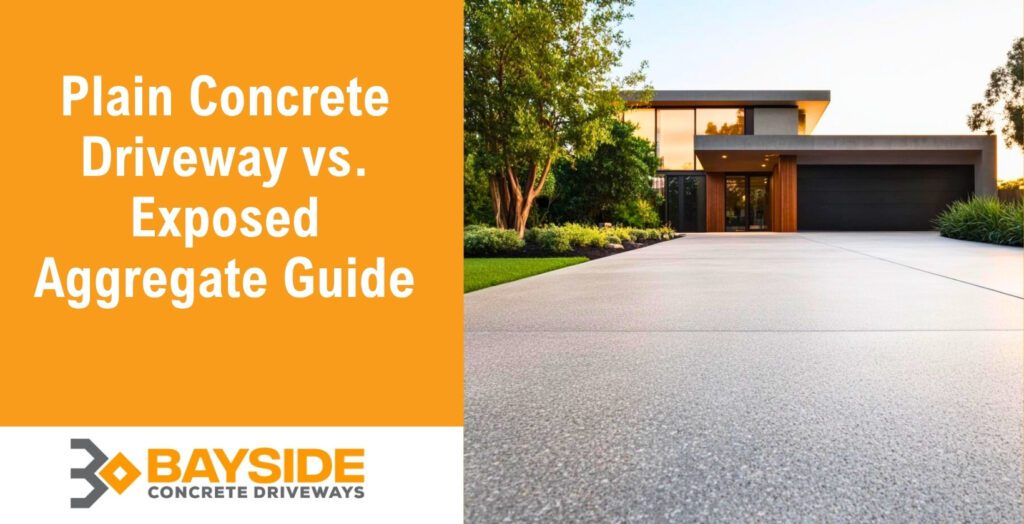Choosing between a plain concrete driveway and exposed aggregate comes down to more than just looks. A finished concrete driveway handles wear, weather, and budgets differently depending on the surface. Whether you’re after something clean and simple or textured with visual depth, it pays to understand the pros and cons of both.
In this guide, we’ll cover definitions, cost considerations, appearance, durability, and the full installation process—so you can decide which one suits your home best.
Plain Concrete Driveway and Exposed Aggregate Comparisons
| Feature | Plain Concrete Driveway | Exposed Aggregate Driveway |
|---|---|---|
| Aesthetic Appeal | Smooth, flat finish | Textured, decorative stone mix |
| Durability | Solid with regular sealing | More resilient, hides wear and stains |
| Maintenance | More cleaning required | Lower upkeep over time |
| Cost (per m²) | $100 to $150 | $140 to $220 |
The 4 major differences between plain concrete and exposed aggregate driveways include visual appearance, durability, maintenance effort, and cost per square metre. Each surface suits different property types, site conditions, and budgets.
Let’s take a closer look below.
Aesthetic Appeal
The main visual difference is that a plain concrete driveway has a flat, uniform finish that matches modern or minimal designs. Exposed aggregate highlights decorative stones like crushed granite, quartz, or basalt across the surface. The textured finish adds depth and grip, making it more eye-catching and slip-resistant than plain concrete.
Durability and Maintenance
Both surfaces last over 20 years with correct sealing. A plain concrete driveway is more prone to visible wear—tyre marks, oil stains, and cracks show clearly. Exposed aggregate offers better resistance to daily wear and masks surface flaws. Both require sealing every 2–3 years, but exposed aggregate usually needs less frequent cleaning.
Cost Considerations
The average cost of a plain concrete driveway is $100 to $150 per square metre, making it the more affordable option for most projects. Exposed aggregate costs more at $140 to $220 per square metre due to the added labour, washing process, and decorative materials.
Learn more about concrete driveway costs here.
Exposed Aggregate and Plain Concrete Driveway Installation Process
The installation process for both driveway types starts similarly but differs in surface finishing. Understanding each method helps with planning timeframes, labour needs, and costs. One key step people often overlook is understanding what is formwork, which plays a vital role in shaping the slab.
Below are the steps involved for each.
Here are the steps to choose the right type of concrete driveway.
Plain Concrete Driveway Installation Steps
Installing a plain concrete driveway involves these 4 steps:
Step 1: Site Excavation and Base Preparation
Formwork is installed around the driveway boundary to hold the wet concrete in place. Timber or steel forms are secured tightly, ensuring straight lines and accurate depth. Reinforcement mesh is laid inside the formwork to increase the slab’s strength and reduce cracking.
Step 2: Formwork Setup and Reinforcement
Think about your skills, time, and tools. Laying and finishing concrete requires experience to get levels, drainage, and curing right. For finishes involving texture or colour, professional concreters deliver a far better result.
Step 3: Concrete Pouring and Levelling
Concrete is poured and spread evenly across the surface. A screed board is used to level the slab and remove any high points. The slab is then allowed to set just enough before applying the final finish.
Step 4: Surface Finishing and Curing
A broom, trowel, or float finish is applied, depending on the desired look. Once finished, the surface is covered or sprayed to retain moisture and begin curing. A plain concrete driveway needs at least 7 days of curing for full strength.
Exposed Aggregate Driveway Installation Steps
Exposed aggregate follows a similar base process with a different surface treatment:
Step 1: Ground Preparation and Base Installation
Excavation begins with clearing the site and compacting the soil. A crushed rock base is added and levelled to create a solid foundation. This step mirrors the plain concrete process to ensure structural integrity.
Step 2: Concrete Pour with Decorative Aggregates
Concrete is poured with decorative stones already mixed into the batch. The slab is spread and levelled using a screed. During this step, care is taken not to overwork the surface and push the stones too deep.
Step 3: Surface Retarder Application
A surface retarder is sprayed after the concrete is levelled. This slows the curing process on the top layer, allowing the stones to stay exposed. Timing is critical—too early or too late can affect the final result.
Step 4: Aggregate Exposure and Final Curing
Once partially set, the surface is pressure washed to remove the cement paste and expose the stones. The exposed surface is then sealed to protect it from stains and wear. Curing continues over the next week to harden the slab fully.
When to Choose a Plain Concrete Driveway
A plain concrete driveway is ideal when budget, simplicity, or speed are your top priorities. It suits both residential and light commercial properties with standard vehicle traffic.
Choose this option if:
- You want a fast install at a lower cost
- You’re working with flat, square or rectangular layouts
- Minimalist or contemporary design matches your home
This choice is common for property owners seeking low-maintenance driveway ideas that balance function and affordability.
When to Choose an Exposed Aggregate Driveway
Exposed aggregate works best where visual impact and surface traction matter. Its textured finish suits homes on slopes or areas exposed to rain, where grip is essential. It also pairs well with landscaping or decorative edging.
Opt for exposed aggregate if:
- You prefer a premium, textured appearance
- Your driveway sees regular use or heavier vehicles
- You’re after a surface that hides marks and looks sharp long term

